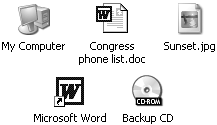Microsoft Windows XP is the latest and, technically speaking, the best version of the most-used software in the world. If you recently bought a new PC, Windows XP probably came preinstalled. If you already own a computer (running Windows 98, 2000, or Me, for example), you can buy Windows XP separately to upgrade your machine (see Appendix A).
No matter how you get it on your PC, however, you’ll be spending a lot of time with Windows XP. It’s your computer’s face; it’s the first thing that greets you when you turn on your machine, and the last thing you see before it blinks off.
Windows is an operating system, the software that controls your computer. It’s designed to serve you in several ways:
It’s a launching bay. At its heart, Windows is a home base, a remote-control clicker that lets you call up the various software programs (applications) you use to do work or kill time. When you get right down to it, applications are the real reason you bought a PC.
Windows XP is a well-stocked software pantry unto itself; for example, it comes with such basic programs as a Web browser, email program, a simple word processor, and calculator. Windows XP comes with eleven games, too, several of which you can play live against other people on the Internet. (Chapter 7 covers all of these freebie programs.)
If you were stranded on a desert island, the built-in Windows XP programs could suffice for everyday operations. But if you’re like most people, sooner or later, you’ll buy and install more software. That’s one of the luxuries of using Windows: You can choose from a staggering number of add-on programs. Whether you’re a left-handed beekeeper or a German-speaking nun, some company somewhere is selling Windows software designed just for you, its target audience.
It’s a file cabinet. Every application on your machine, as well as every document you create, is represented on the screen by an icon (see Figure 1-1). You can organize these icons into little onscreen file folders. You can make backups (safety copies) by dragging file icons onto a floppy disk or blank CD, or send them to people by email. You can also trash icons you no longer need by dragging them onto the Recycle Bin icon.
Figure 1-1. Your Windows world revolves around icons, the tiny pictures that represent your programs, documents, and various Windows components. From left to right: the icons for your computer itself, a word processing document, a digital photo (a JPEG document), a word processor program (Word), and a CD-ROM inserted into your computer.
It’s your equipment headquarters. What you can actually see of Windows is only the tip of the iceberg. An enormous chunk of Windows is behind-the-scenes plumbing that controls the various functions of your computer—its modem, screen, keyboard, printer, and so on.
Get Windows XP Home Edition: The Missing Manual now with the O’Reilly learning platform.
O’Reilly members experience books, live events, courses curated by job role, and more from O’Reilly and nearly 200 top publishers.


